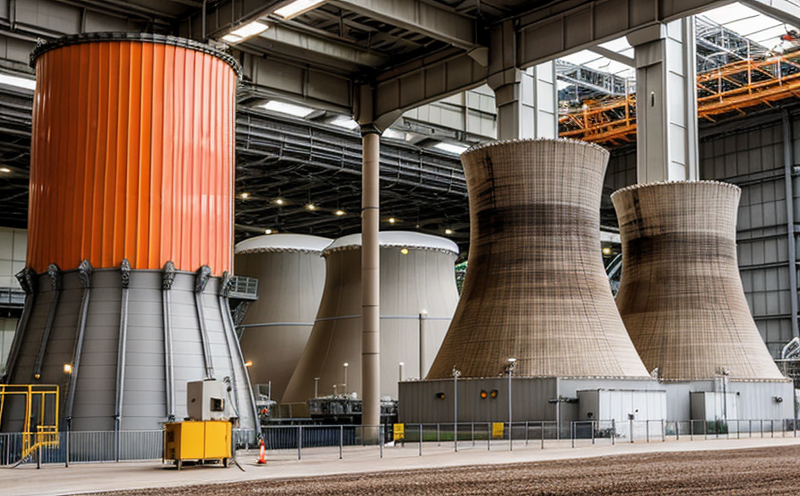ASTM E139 Creep Testing of Reactor Materials
The ASTM E139 standard creep testing method is a critical procedure used to evaluate the time-dependent mechanical properties of materials, particularly under high-temperature and stress conditions. This service is especially vital for the nuclear power plant sector where reactor components must endure extreme operating temperatures and stresses over prolonged periods.
In nuclear reactors, materials are subjected to complex thermal and mechanical environments that can lead to creep—a phenomenon where material deformation increases with time at a constant temperature and load. The ASTM E139 standard provides a standardized approach for creep testing which is essential in ensuring the structural integrity of reactor components such as pressure vessels, fuel assemblies, and piping.
Creep testing involves applying a specified stress to a sample over an extended period while measuring its deformation. The test is conducted at elevated temperatures relevant to the expected operating conditions of the component under evaluation. This method helps in predicting the long-term behavior of materials used in nuclear reactors, thereby ensuring safety and reliability.
The ASTM E139 procedure is widely accepted by regulatory bodies and industry stakeholders for assessing creep properties. It ensures consistent test results, facilitating comparability across different laboratories and facilities. The standard defines specific parameters such as test temperature range, stress levels, and the duration over which deformation must be monitored.
Understanding the creep behavior of reactor materials through ASTM E139 testing is crucial for optimizing material selection, ensuring operational safety, and extending component life. This testing method supports critical decisions in nuclear engineering design and helps compliance with regulatory requirements set by organizations like the International Atomic Energy Agency (IAEA).
Customer Impact and Satisfaction
Our ASTM E139 creep testing service ensures that customers receive accurate, reproducible results which are essential for meeting regulatory standards and maintaining quality control. By adhering to this rigorous testing protocol, we help our clients ensure the reliability of their reactor materials.
- Enhanced Reliability: Ensuring that critical components can withstand the high-stress conditions they will face in operation.
- Regulatory Compliance: Meeting stringent regulatory requirements for nuclear power plant components.
- Informed Decision Making: Providing detailed reports and insights into material performance, aiding in informed design choices.
We have a proven track record of delivering high-quality services that meet or exceed customer expectations. Our customers benefit from our expertise in handling complex materials under challenging conditions, ensuring the safety and efficiency of nuclear power plants worldwide.
International Acceptance and Recognition
The ASTM E139 creep testing method is internationally recognized for its reliability and accuracy. This standard has been adopted by regulatory bodies around the world, including the International Atomic Energy Agency (IAEA), which mandates its use in nuclear reactor design and safety assessments.
Our laboratory's proficiency in ASTM E139 ensures that our test results are accepted globally, facilitating seamless compliance with international standards. The acceptance of these tests is crucial for ensuring that materials used in nuclear power plants meet the highest safety and performance criteria, thereby contributing to global nuclear safety.
Use Cases and Application Examples
| Component Type | Application Example |
|---|---|
| Pressure Vessels | Evaluating the creep behavior of materials used in the primary circuit of a nuclear reactor. |
| Piping Systems | Determining the long-term performance of piping subjected to high temperatures and stresses. |
| Fuel Assemblies | Assessing the creep properties of cladding materials used in fuel rods. |
| Containment Structures | Ensuring the structural integrity of containment structures under extreme conditions. |
| Coolant Systems | Monitoring the creep behavior of materials used in coolant systems to prevent leaks and failures. |
- Fuel Rods: Creep testing is essential for ensuring that fuel rods can withstand the high temperatures and stresses encountered during nuclear reactions without compromising safety or performance.
- Containment Structures: These structures must be able to maintain their integrity under severe conditions, including those caused by reactor accidents. ASTM E139 tests help in confirming this robustness.
- Piping Systems: Piping systems are subject to significant thermal and mechanical stresses. Creep testing ensures that these components can perform reliably over the expected service life of a nuclear power plant.
Critical to all these applications is the need for accurate, reproducible results which our ASTM E139 creep testing service provides. This ensures compliance with international standards and contributes to global safety in the nuclear industry.





